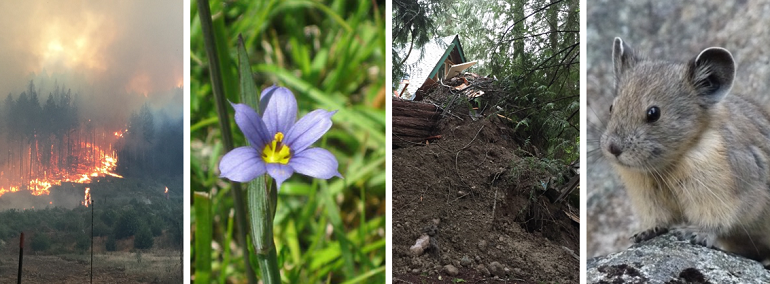
NHP Climate Change
Washington state is already experiencing impacts from a changing climate: the Pacific Northwest warmed about 1.3°F during the past century, the frost-free season has grown longer, sea levels have risen along most of Washington’s coast, ocean water is more acidic, glacial area and snowpack have decreased, and peak streamflows are occurring earlier in many rivers (Snover et al. 2013).
Staff with the Washington Natural Heritage Program (WNHP) are addressing the threats posed by our changing climate to our state’s native species and ecosystems in several ways.
Assessing Species Vulnerability
WNHP is using the NatureServe Climate Change Vulnerability Index (CCVI) to translate research findings into useful guidelines that will enable land managers and policy-makers to identify emerging and anticipated threats to biodiversity. The CCVI identifies plant and animal species that are particularly vulnerable to the effects of climate change. Using the Index, WNHP staff use information about a species’ natural history, distribution and landscape context to predict whether it is likely to suffer a range contraction and/or population reductions due to climate change. You can read more about the CCVI and access assessments that have been completed on our Assessing Species Vulnerability page.
Assessing Natural Areas Resiliency
The State of Washington has invested millions of dollars to identify, acquire and protect, via establishment of Natural Area Preserves and Natural Resources Conservation Areas, several sites that are home to rare plants, animals, and ecosystems. Since these natural areas were established, significant advances have been made in terms of assessing features and sites for their vulnerability to climate change and for evaluating how well they are connected to a functioning landscape.
The WNHP is exploring strategies and actions to improve the viability of sites and the species at these sites. Actions may include a combination of habitat management, enlarging the effective size of individual natural areas, and collaborative planning with land trusts and other land management agencies and organizations to provide compatible management and/or increase connectivity within the landscape.
Citations and Additional Resources
Snover, A.K, G.S. Mauger, L.C. Whitely Binder, M. Krosby, and I. Tohver. 2013. Climate Change Impacts and Adaptation in Washington State: Technical Summaries for Decision Makers. State of Knowledge Report prepared for the Washington State Department of Ecology. Climate Impacts Group, University of Washington, Seattle.
Banner photos: Fires and mudslides are expected to become more common in Washington due to climate change (photos: DNR). Pale blue-eyed grass (Sisyrinchium sarmentosum; photo: DNR) and the American pika (Ochotona princeps; photo: NPS/Anderson) are species that are expected to decline due to climate change.
Acknowledgements
These assessments were completed in part with funding from Region 6 of the U.S. Forest Service.

